Introduction
The Trainers Methodology Level 1 (TM-1) Plan Training Session-Competency Based Learning Materials (PTS-CBLM) under information sheet 1.3-2 defines the components of a CBLM, on page 138, it enumerated the parts of the CBLM, grouped in two, these are:
A. Preliminary pages
- Front Page
- Trainee’s Guide on How to Use the CBLM
- List of Competencies
- Competency Summary
- Learning Outcome Summary
- Learning Experiences
B. Instruction Sheets
- Information Sheet
- Self-Check
- Task Sheet
- Operation Sheet
- Job Sheet
- Performance Criteria Checklist
For this walk-through, let us start with the first group, preliminary pages
1. The Front Page
 |
| Figure 1. Competency Based Learning Material Cover Page |
Although there is no defined standards as to how the front page is supposed to be formatted in regards to a well developed CBLM, the PTS-CBLM has a recommended format that a Trainers Methodology Level 1 Trainee is advised to follow.
The recommended layout is self explanatory and has been properly explained in page 139 and will no longer be covered by this walk-through. The entire PTS template can be downloaded as a zip file at the template area or you can click here to download the cover page.
Tip: For your CBLM portfolio requirements, use the Core competency that you have chosen for your Session Plan.
2. Trainee Guide on How to Use the CBLM
 |
| Figure 2. Sample Trainee Guide |
For the Trainee Guide (figure 2), you are required to develop your own, however, given that there is some similarity in regards to what a CBLM is supposed to be, you can use pre-developed Trainee Guide as a reference or as a starting point for the development of your own, just ensure that its contents conforms to your respective qualification and meets what you intend for your respective CBLM. The Trainee guide templates can be also be downloaded at this link.
Tip: For your portfolio requirements, use the Core competency that you have used when developing your Session Plan.
3. List of Competencies
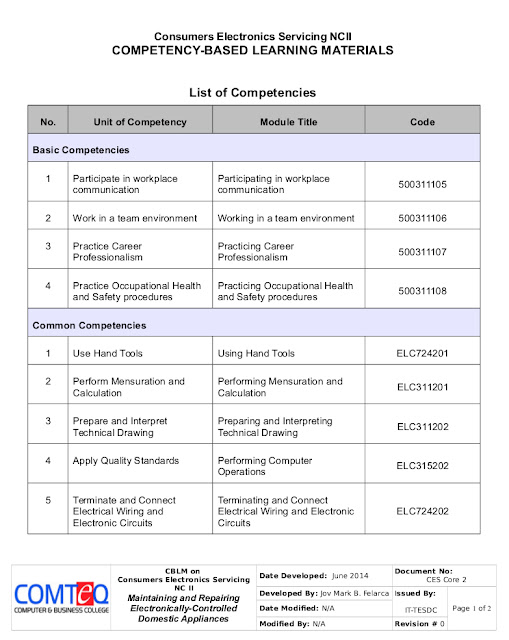 |
| Figure 3a. List of Competencies |
 |
| Figure 3b. Sample List of Competencies |
The contents of the list of competencies is self explanatory, the template is also available for download in the templates section of this blog or you can click here.
Tip: Ensure that you highlight the Core Competency that you have chosen to use for your session plan as shown in figure 3b.
4. Competency Summary
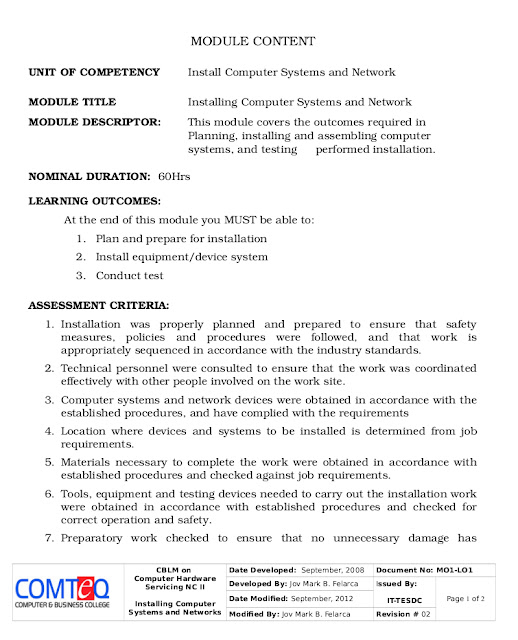 |
| Figure 4. Sample Module Contents |
Also known as Module Content / Module of Instructions. All its contents are taken from the TR or the CBC. Template is also available at the Template Area or you can download it here.
Tip: For your portfolio requirement, use the core competency that you used in the development of your Session Plan and write down all Performance Criteria as Assessment Criteria of the entire Core Competency.
5. Learning Outcome Summary
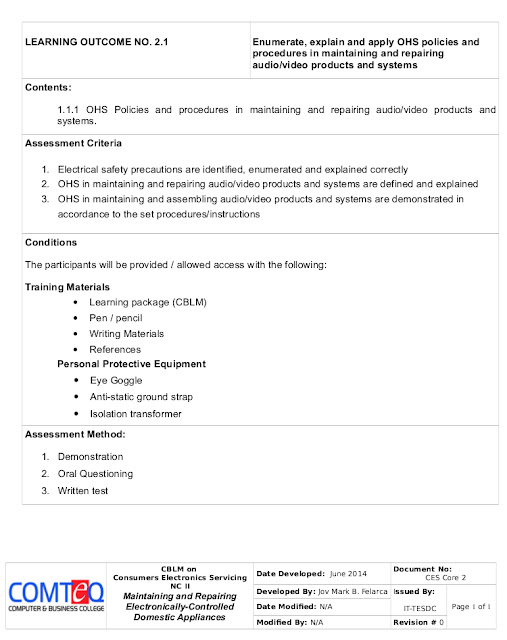 |
| Figure 5. LO Summary |
Similar to Competency Summary, most of its contents are taken from the TR or the CBC. Template is also available at the templates area and similarly can also be downloaded here.
Tip: For your portfolio requirements, from the Session plan that you have recently developed, select one of your Learning Outcomes with an Information Sheet, and a task, a job, an operation sheet or any combination of these three.
6. Learning Experiences
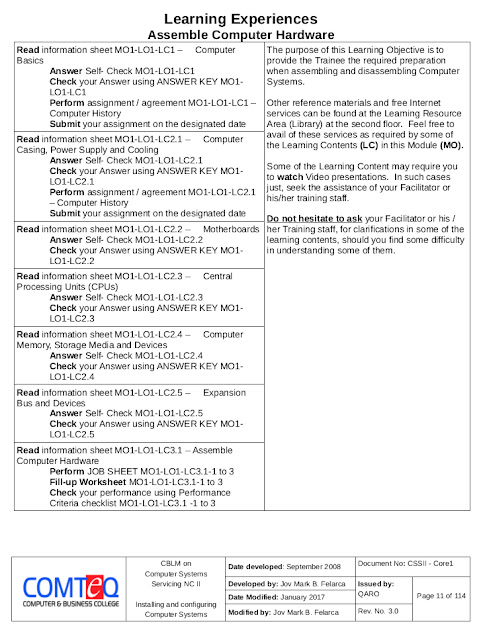 |
| Figure 6. Sample Learning Experiences |
For this last part of your preliminary pages, you are required to list down all content of your session plan under presentation, practice and feedback. Aside from this you can also include special guidelines that your Trainee needs to know, as shown in this Sample Learning Experience (figure5). You can Download the PTS templates at the templates area or download the Learning Experience template here.
Writing your Instructions Sheets.
The PTS-CBLM defines Instruction sheets as a document "designed to guide the trainee on the different things to be done to learn a unit of competency, different instruction sheets will be required for different learning activities."
These different Instruction Sheets are:
- Information Sheet
- Task Sheet
- Operation Sheet
- Job Sheet
Information Sheet
"Information sheet is not a copy or duplicate of an article from magazine, newspaper or book. An information sheet is developed when there are no resources available to explain the required information or to summarize an article that illustrate new trends and technology and present hard-to-find data. An information sheet is primarily designed to deliver pertinent information needed in the attainment of a learning outcome."
A good information sheet has the following characteristics or conforms to the following criteria:
- Free from violation of copyright law
- Contains information essential to the attainment of the learning outcomes
- Has a title that gives some idea of the coverage of the sheet
- Approach in terms of content and presentation is appropriate to the interest and reading level of the learner
- The layout, text and drawings are attractive in appearance and legible
- Has uncommon terms marked for further defining
- Has acknowledgement per copied part of the sheet
Tips in writing Information Sheets
- Make sure that the reading level matches that of your trainees
- Use short paragraphs
- Use short, concise sentences
- Position illustrations to the side or just below the sentences referring to the illustrations
- Keep information sheet brief
- From PTS-CBLM page 150.
There are lots of ways of writing an information sheet, provided below (figure 7) is one of the possible ways of writing it, while the template for writing information sheets and its corresponding documents can be downloaded here.
 |
| Figure 7. Sample Information Sheet |
For this Learning Outcome of the old CES NC II TR, it focuses more on learning how to assemble an electronic project, given that most of the prerequisites have already been discussed before, there is longer any other topic to learn except for the actual assembly of an Electronic Project, thus, there is no longer a need to write for a self check, but instead, after this Information Sheet follows a Job sheet (Figure 8)
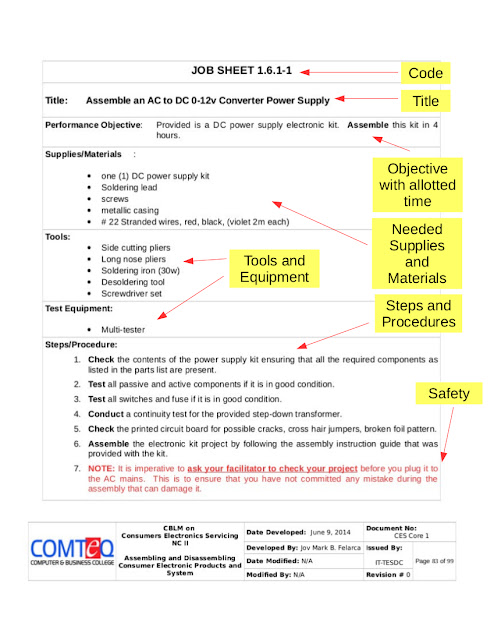 |
| Figure 8a. Sample Job Sheet |
 |
| Figure 8b. Page two of Sample Job Sheet |
Referring to figure 8a and b, As you can see, in order to assemble the Electronic project, the trainee is required to perform different task, from checking all the required materials, individual testing of components and then the actual assembly which makes the assembly a Job, since it's a combination of multiple task. Notice too how the required safety needs was emphasize in the Job Sheet
Every after Job, Task, Operation Sheets follows the performance Criteria Checklist (Figure 9), to develop this document, you need to copy all steps and procedures that you wrote in your job sheet, aside from these, you can also add parts of your performance objectives such time and checked if the trainee has finished the required task/job on time, so that the trainee will be able to check his/her own performance.
Tip: If you want to include portfolio as a requirements before the Trainee can undergo Institutional Assessments, you can collect the performance criteria checklist and include it as part of your portfolio requirements.
Task / Operations Sheets
The
same format is utilized when developing a task sheet and an operation
sheet, the only difference is that, a task sheet focuses in the the
performance of a single task. Example, "Test components" is a single
task, which will only require the trainee to test the functionality of
components, while for an operation sheet, it should contain the
different procedures that the trainee needs to perform to use (operate)
an equipment. Example, "How to use a multi-tester."
This ends this tutorial for now, for my next blog post, I will be delving with writing an Information sheet. Should you have further questions feel free to comment bellow.
Cheers!
Related Topics:
Related Topics:

very helpful. thank you
ReplyDeleteAre elementary schools will also make a cblm?
ReplyDeletevery helpful...thank you
ReplyDelete